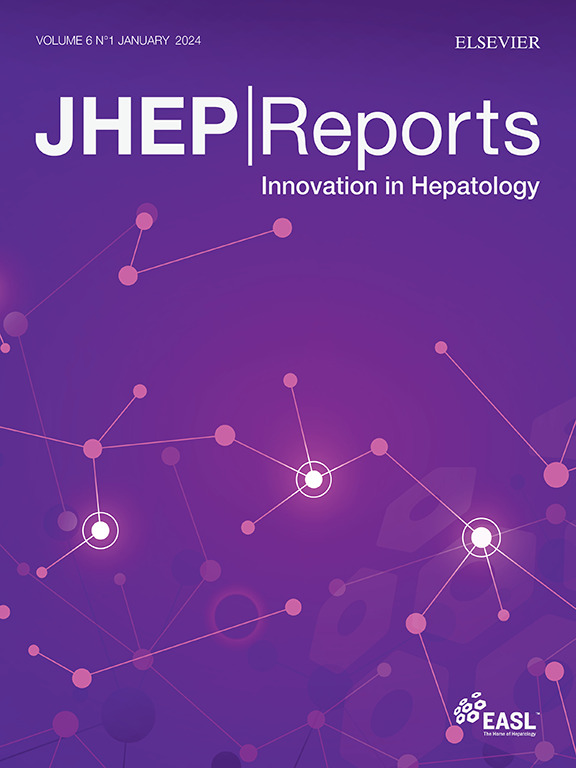Hepatitis D virus infection triggers CXCL9-11 upregulation in hepatocytes and liver infiltration of CXCR3+ CD4 T cells
IF 9.5
1区 医学
Q1 GASTROENTEROLOGY & HEPATOLOGY
引用次数: 0
Abstract
Background & Aims
The role of hepatocytes in producing chemokines and triggering liver inflammation and damage in chronic hepatitis D (CHD) is not fully understood. Herein, we investigated the contribution of primary human hepatocytes (PHHs) infected with HDV in triggering inflammation by producing the chemokines CXCL9–11.
Methods
We performed quantitative PCR, RNA in situ hybridisation, activation-induced marker (AIM) assays, and FACS analysis to investigate the CXCR3/CXCL9–11 receptor/ligand axis of T cells in peripheral blood and livers from patients with chronic hepatitis B (n = 27 and 18, respectively) and CHD (n = 20 and 18, respectively). Chemokine expression was investigated in cultured HDV-infected PHHs and in livers of HBV- or HBV/HDV-infected humanised mice in the presence or absence of adoptively transferred human immune cells (n = 35 in total).
Results
In patient and chimeric mouse livers, higher expression levels of CXCL9–11 were found in an HBV/HDV-coinfected vs. HBV-mono-infected setting. Similarly, high levels of CXCL9–11 were observed in HDV-infected PHHs in vitro. Analysis by RNA in situ hybridisation on patient livers revealed that HDV-infected hepatocytes were a significant contributor to the chemokine expression. The corresponding chemokine receptor CXCR3 was found upregulated specifically on peripheral bulk CD4 T cells of patients with CHD. CXCR3 upregulation was unspecific and was not detected on HDAg- or HBsAg-specific CD4 T cells by activation-induced marker assay. Lastly, adoptive transfer of human T cells in humanised mice led to recruitment of non-HBV/HDV-specific CD4+ T cells only in the setting of HBV/HDV coinfection, but not in HBV-mono-infected mice.
Conclusions
HDV infection upregulated the intrahepatic expression of the CXCL9–11/CXCR3 receptor/ligand axis. Higher amounts of HBV/HDV-unspecific CD4 T cells expressing CXCR3 may contribute to the aggravated liver inflammation frequently observed in patients with CHD.
Impact and implications
Chronic hepatitis D (CHD) causes the most severe form of viral hepatitis, and treatment options are still limited; therefore, a more precise understanding of CHD immunopathology is needed. In this study, we demonstrated that HDV infection triggers CXCL9–11 expression in hepatocytes and liver infiltration of CXCR3-expressing CD4 T cells in preclinical models as well as patient biopsies. Because recruitment of Th1-polarised CD4 T cells to the liver has been also described for other severe liver diseases, such as autoimmune hepatitis, it may represent an important mechanism of aggravating liver diseases. The data of this study set hereby the basis for future studies analysing phenotype and function of intrahepatic T cells in CHD.

求助全文
约1分钟内获得全文
求助全文
来源期刊

JHEP Reports
GASTROENTEROLOGY & HEPATOLOGY-
CiteScore
12.40
自引率
2.40%
发文量
161
审稿时长
36 days
期刊介绍:
JHEP Reports is an open access journal that is affiliated with the European Association for the Study of the Liver (EASL). It serves as a companion journal to the highly respected Journal of Hepatology.
The primary objective of JHEP Reports is to publish original papers and reviews that contribute to the advancement of knowledge in the field of liver diseases. The journal covers a wide range of topics, including basic, translational, and clinical research. It also focuses on global issues in hepatology, with particular emphasis on areas such as clinical trials, novel diagnostics, precision medicine and therapeutics, cancer research, cellular and molecular studies, artificial intelligence, microbiome research, epidemiology, and cutting-edge technologies.
In summary, JHEP Reports is dedicated to promoting scientific discoveries and innovations in liver diseases through the publication of high-quality research papers and reviews covering various aspects of hepatology.
 求助内容:
求助内容: 应助结果提醒方式:
应助结果提醒方式:


